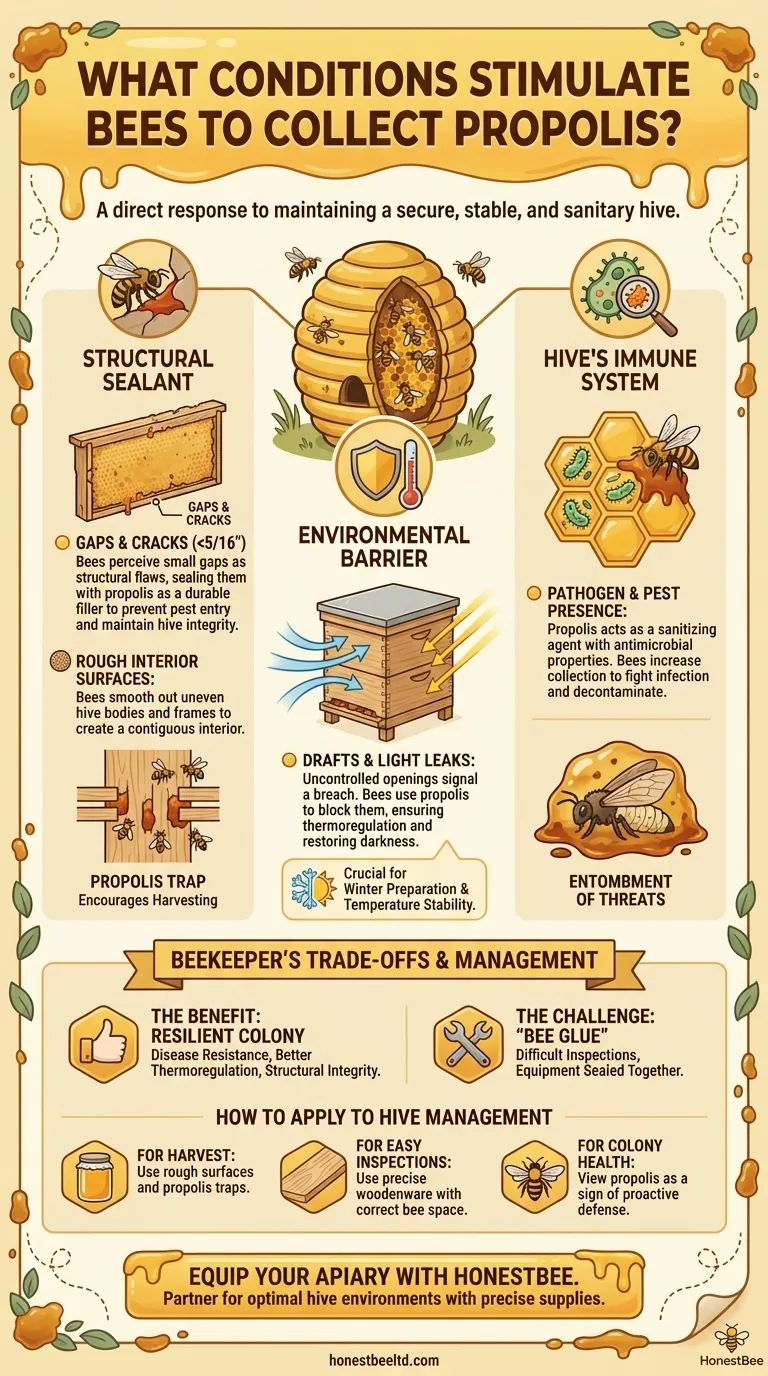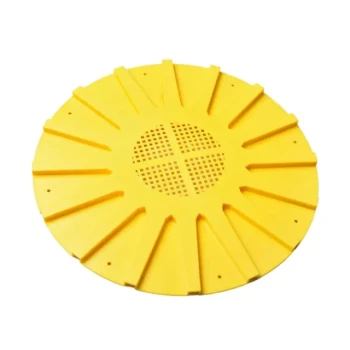Bees are stimulated to collect propolis primarily by structural and environmental imperfections within their hive. This behavior is a direct response to the colony's need to maintain a secure, stable, and sanitary living space. The most common triggers include rough interior surfaces, unwanted drafts, light leaks, and any cracks or gaps that are smaller than the standard "bee space" of about 5/16th of an inch.
Propolis collection is not a random chore; it is a deliberate and vital behavior driven by the bees' instinct to seal, sanitize, and secure their home against external threats. Understanding these triggers allows a beekeeper to see the hive through the colony's eyes, viewing propolis as a sign of the bees' effort to perfect their environment.

The Core Functions Driving Propolis Collection
To understand the stimuli for collection, we must first understand the purpose of propolis from the bees' perspective. Bees manufacture propolis by mixing the protective resins they gather from trees and leaf buds with their own enzymes and beeswax. They use this remarkable substance to serve three critical functions.
A Structural Sealant
Bees are masters of efficiency and architecture. Any crack or gap that is too small for a bee to pass through (less than 5/16") is considered a structural flaw.
These imperfections disrupt airflow, allow light to enter, and can harbor pests or pathogens. Bees instinctively use propolis as a durable filler to seal these gaps, creating a solid, secure hive interior.
An Environmental Barrier
The colony's survival depends on maintaining a stable internal environment. Propolis is a key tool for this.
Bees use it to block drafts and waterproof the hive, which is crucial for thermoregulation. This behavior often increases in the fall as the colony prepares for winter, ensuring their home is insulated and protected from moisture.
The Hive's Immune System
Plant resins, the raw ingredient for propolis, have potent antimicrobial and antifungal properties that protect the plant from infection. Bees harness this for their own use.
When a colony detects a disease or pathogen, it will increase propolis collection to sanitize the hive. They use it to coat surfaces, line cells before the queen lays, and even entomb invaders that are too large to remove, effectively mummifying the threat.
Common Triggers and How They Work
The bees' drive to seal, insulate, and sanitize translates into specific triggers that a beekeeper can observe and even influence.
Rough Interior Surfaces
Bees prefer a smooth, contiguous interior. Rough or uneven surfaces on hive bodies or frames provide countless small imperfections for bees to fill. This is the principle behind a propolis trap, which is essentially a plastic mat with a pattern of small gaps designed to stimulate this behavior for easy harvesting.
Gaps, Drafts, and Light
A bee colony perceives any uncontrolled opening that is not a functional entrance as a vulnerability.
Drafts and light leaks signal a breach in the hive's envelope. The bees will diligently work to find the source of these leaks and seal them with propolis to restore the integrity and darkness of their nest.
Pathogen and Pest Presence
Propolis collection is an active part of the colony's immune response. If a hive is battling a disease like chalkbrood or has pests present, you may see an increase in propolis use.
This is a sign that the bees are actively using propolis's medicinal properties to fight infection and decontaminate their living space.
Understanding the Trade-offs
For the beekeeper, propolis presents a duality: it is both a sign of a healthy, industrious colony and a potential nuisance.
The Benefit: A Resilient Colony
A hive that produces ample propolis is often stronger and healthier. The substance aids in disease resistance, helps the colony manage its internal temperature more efficiently, and contributes to overall structural integrity.
The Challenge: "Bee Glue"
The downside is purely mechanical. Excessive propolis can act like a powerful glue, making it extremely difficult to remove frames for inspection. It can seal inner covers to hive bodies and cement equipment together, requiring significant force to separate.
How to Apply This to Your Hive Management
Your approach to propolis should align with your specific goals as a beekeeper.
- If your primary focus is harvesting propolis: Introduce rough surfaces, like a dedicated propolis trap, and use equipment with small, intentional gaps to encourage the bees' sealing behavior.
- If your primary focus is easier hive inspections: Use smooth, precisely milled woodenware with correct bee spacing to minimize the cracks and rough spots bees feel compelled to fill.
- If your primary focus is overall colony health: View propolis production not as a nuisance, but as a key indicator of your bees' proactive efforts to maintain a secure and hygienic home.
By recognizing what stimulates propolis collection, you move from simply managing a hive to truly partnering with your colony's powerful natural instincts.
Summary Table:
| Stimulus | Bee's Perception | Propolis Action |
|---|---|---|
| Gaps & Cracks (< 5/16") | Structural flaw, pest entry point | Seal with propolis as a durable filler |
| Drafts & Light Leaks | Breach in hive envelope, temperature instability | Block to restore darkness and thermoregulation |
| Rough Surfaces | Imperfections needing smoothing | Fill to create a smooth, contiguous interior |
| Pathogens & Pests | Disease threat requiring sanitization | Coat surfaces and entomb invaders to fight infection |
Equip your apiary to support natural bee behaviors. A colony that collects propolis is a resilient colony, actively managing its health and environment. At HONESTBEE, we supply commercial apiaries and beekeeping equipment distributors with the precise, high-quality supplies needed to manage propolis effectively—from smooth, well-spaced woodenware that minimizes excessive 'bee glue' to dedicated propolis traps for harvest-focused operations.
Partner with HONESTBEE to provide your bees with the optimal environment. Contact our wholesale experts today to discuss equipment solutions tailored to your specific hive management goals.
Visual Guide

Related Products
- Electric Flatting and Embossing Machine with Tray for Beekeeping
- Professional Galvanized Hive Strap with Secure Locking Buckle for Beekeeping
- Retractable Chinese Queen Rearing Grafting Tools Equipment
- Stainless Steel Honey Press Wax Press with Tank
- Stainless Steel Manual Honey Press with Guard for Pressing Honey and Wax
People Also Ask
- What are the primary products of honey bee farming besides honey? Discover the Hive's Hidden Treasures
- What qualities are important for someone starting in beekeeping? Build a Thriving Apiary with the Right Mindset
- How does pressed honey compare to extracted or crush-and-strain? Unlock the Full Flavor of the Hive
- What tools are used to add intricate details to beeswax sheets? Find the Right Embossing Method for Your Scale
- What tools are used to cut wax foundations? The Essential Guide for a Perfect Fit



















